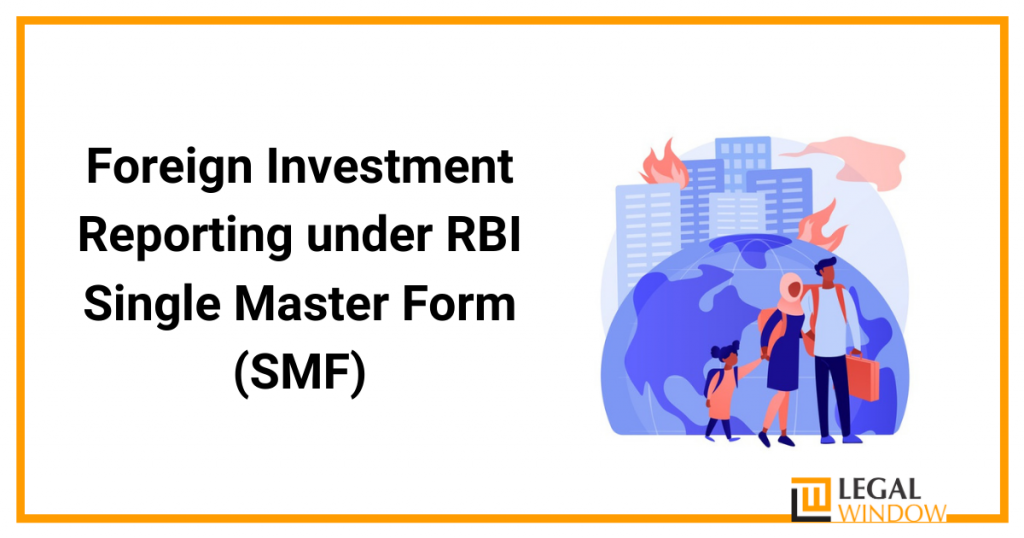Foreign Investment Reporting under RBI Single Master Form (SMF)
- February 23, 2021
- Company Law
Foreign investment in India is required for the development of the economy and improvement of the gross domestic product. However, when receiving foreign investment, there is a requirement of compliance under the respective foreign exchange laws. One such law that is enacted by the Parliament is the Foreign Exchange Management Act, 1999 (FEMA). The regulatory body that checks and administers foreign investment in India is the RBI. RBI also amends the rules relating to foreign investment. When an applicant is making an application for receiving foreign investment, there is a particular procedure for doing the same. In September 2018, the RBI brought out the manual regarding the process of Single Master Form (SMF) for reporting requirements regarding Foreign Investment Received in India. By having this process of reporting under the Single Master Form, the RBI can keep monitoring the amount of foreign investment received in India. This would also put a system in place to keep track of the application for foreign investment.
What is Single Master Form?
- RBI has introduced SMF on 01/09/2018 and merged 9 reporting forms into a single form, RBI also released a user manual (the “SMF Manual “) which clearly prescribed the procedure for filing a single master form (the “SMF “). With the introduction of SMF, ARF has been discontinued with effect from September 01, 2018. Now, a user is required to make a report of FDI received in the section under FCGPR only.
- Reporting in SMF (provide one platform for making a different kind of reporting)
- After getting the Entity user registration, the entity required to get the business user registration as well. For this, you need to go on https://firms.rbi.org.in/firms/ and select Registration Form for Business User and fill the necessary details and attach the authorization letter (the format of this letter is given in user manual for SMF). Please note that this registration can also be availed by an individual in the case where a resident individual is required to report.
- AD Banker is authorized to process such Business user application therefore one should contact AD bank to whom the reporting was made (as per the IFSC chose or branch at the time of Business User registration).

Requirement of having an RBI Single Master Form of Reporting
This process of RBI Single Master Form reporting of Foreign Investment in India has certain benefits to the country:
- Improves the Economy and GDP of India.
- Assists in keep track of the amount of foreign investment received in India.
- Assists in monitoring the application status of the applicant regarding the grant or opposition of the investment.
- Through the RBI Single Master Form, compliance with the FEMA can be controlled.
Who can make an application under the RBI Single Master Form?
The following entities can make an application under the RBI Single Master Form:
- A company which is defined as per the Companies Act 2013
- An LLP
- A start-up
Forms replaced by the SMF
The SMF Manual states that all Indian entities will be mandatorily required to file the SMF from September 1, 2018.
Under the SMF, the reporting of foreign direct investment (“FDI”), which was previously a two-step procedure, comprising the Advance Remittance Form (“ARF”) and Form FC-GPR, has now been merged into a single Form FC-GPR. Therefore, the previous requirement of an ARF has now been done away with.
Presently, the SMF replaces the following forms:
- FC-TRS – The form is used for the transfer of capital instruments from a foreign resident to a person in India.
- FC-GPR- The form which is used for issue of capital instruments by an Indian Company to a person resident outside India
- LLP-I- The form is used for Foreign Direct Investment, which is required by an LLP.
- LLP-II-The form which is used for Divestment or transfer of capital contribution in an LLP
- CN – The form which is used for the issue or to transfer convertible notes
- DRR- The form which is used for issue of transfer of depository receipts
- ESOP- The form which is used for issuing employee stock options or sweat equity shares
- DI- The form which is used for reporting of downstream investment or some form of foreign indirect investment in a business
- InVi- The form used for reporting of investment by a foreign investor in an investment machine.
Apart from replacing the nine forms for foreign investment, the RBI Single Master Form provides the applicant to monitor the status of the application.
Procedure for filing the SMF
Under the previous procedure for filing any form under FEMA, there were two levels of verification and scrutiny. The first was at the level of authorized dealer banks (“AD Banks”) and the second was at the level of the RBI.
The most crucial change brought about by the SMF is that the RBI will no longer scrutinize every FEMA filing. All SMF filings will need to be completed by Indian entities, and verified, scrutinized and acknowledged or rejected by their respective AD Banks. The RBI’s role in the entire SMF process has now been minimized.
We highlight, in brief, the procedure to file an SMF, below.
- The SMF has to be filed by an applicant, who is termed a business user (a “BU”) in the SMF Manual. The BU must report the relevant transaction in the SMF through FIRMS, by using login credentials for the entity which has authorized him or her to report the relevant transaction. If a person wants to act as the BU for another entity, he or she must register himself or herself separately.
- The SMF Manual also sets out the procedure for the BU to register himself or herself on FIRMS.15 At the time of registration, the BU will be required to select the Indian Financial System Code, or the IFSC code, of the bank which will be approving the eKYC.
- After the BU submits the registration form, he or she must also submit an authority letter,16 authorizing the relevant AD Bank to conduct the eKYC. The concerned AD Bank will then verify this form, along with the authority letter. The SMF Manual defines ‘eKYC’ as a type of verification, which every BU must complete before filing the SMF. eKYC is the sole responsibility of AD Banks. It appears that the eKYC verification is limited to verifying the registration form and authority letter to be submitted by the BU. AD Banks will have 3 working days to verify the eKYC of a BU, once the eKYC documents have been uploaded to FIRMS by the BU.
- After the eKYC is completed, the SMF will be filed, through the procedure set out for each of the five forms which the SMF has replaced. As soon as the BU starts filing the SMF, a unique reference number will be generated for the filed SMF. Given that the ARF has been rendered redundant with the introduction of the SMF, no unique identification number (a “UIN”) will be generated for any FEMA filing in the SMF. Therefore, it appears that this unique reference number is intended to replace the requirement of obtaining a UIN.
- AD Banks will then be required to verify the SMF filed by the relevant entity. A checklist will be provided to the concerned AD Bank, which will set out the details to be verified for acknowledging the filed SMF. If the details are in order, AD Banks will approve the form. If not, they will reject it. The SMF Manual gives AD Banks a time period of 5 working days from the entity filing the SMF, to approve or reject the form.
- Upon successful acknowledgement of the filed forms at the AD Bank level, the details under the EMF will be updated automatically, and will include the revised shareholding pattern of the Indian entity after it has received the foreign investment.
Penalty provisions for making an application under the RBI Single Master Form
Non Compliance by an entity would attract severe penalty provisions under FEMA. Apart from this, if the applicant provides any misleading information or delays in providing information without any reasonable cause, then they would not be allowed to receive any foreign investment for carrying out their activities.
Conclusion
Hence, it can be understood that the new system of the RBI Single Master Form (SMF) to receive foreign investment is simplified and straightforward. The new system has abolished the requirement of having multiple forms under the e-biz portal. There is no requirement for the applicant to fill the form of remittance, such as the ARF. They would just require filing the Form FC-GPR. The role played by the RBI is minimized as it does not act as the ultimate authority for reviewing all the applications. In the previous system, the RBI was the foremost authority in scrutinizing applications, and the authorized bank just acted as a medium through which applications are sourced. In the RBI Single Master Form system, the authorized bank only has to work on the applications, thus reducing the burden for the RBI.
CS Urvashi Jain is an associate member of the Institute of Company Secretaries of India. Her expertise, inter-alia, is in regulatory approvals, licenses, registrations for any organization set up in India. She posse’s good exposure to compliance management system, legal due diligence, drafting and vetting of various legal agreements. She has good command in drafting manuals, blogs, guides, interpretations and providing opinions on the different core areas of companies act, intellectual properties and taxation.
Categories
- Agreement Drafting (23)
- Annual Compliance (11)
- Change in Business (36)
- Company Law (148)
- Compliance (90)
- Digital Banking (3)
- Drug License (3)
- FEMA (17)
- Finance Company (42)
- Foreign Taxation (6)
- FSSAI License/Registration (14)
- GST (120)
- Hallmark Registration (1)
- Income Tax (202)
- Latest News (34)
- Miscellaneous (165)
- NBFC Registration (8)
- NGO (14)
- SEBI Registration (6)
- Section 8 Company (7)
- Start and manage a business (21)
- Startup/ Registration (130)
- Trademark Registration/IPR (40)
Recent Posts
About us
LegalWindow.in is a professional technology driven platform of multidisciplined experts like CA/CS/Lawyers spanning with an aim to provide concrete solution to individuals, start-ups and other business organisation by maximising their growth at an affordable cost.








